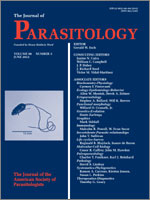The parasitic dinoflagellate Hematodinium sp. parasitizes blue crabs along the Atlantic seaboard of the United States. Infections in blue crabs have only been reported from waters where salinity is >11 practical salinity units (psu). Blue crabs maintain a hyperosmotic internal concentration at low salinities (0–5 psu), roughly comparable to 24 psu, and should be capable of maintaining an infection in low-salinity waters even if Hematodinium spp. cells are intolerant of low salinities. We tested this notion by observing the effect of low salinity on the progression of disease in crabs experimentally infected with the parasite. Blue crabs were acclimated to 5 psu or 30 psu salinity treatments. They were inoculated with Hematodinium sp. and necropsied 3, 7, 10, and 15 days post-inoculation. The low-salinity treatment did not have an effect on the proliferation of Hematodinium sp. infections in blue crabs; moreover, a greater proportion of infections in crabs in the low-salinity treatment developed dinospore stages than did those in the high-salinity treatment, indicating that salinity may affect the development of the parasite. However, dinospores from in vitro cultures rapidly became inactive when held in salinities <15 psu. Our experiments indicate that Hematodinium spp. can develop in blue crabs at low salinities, but that the parasite is incapable of transmission in this environment, which explains the lack of natural infections in crabs at low salinities.
How to translate text using browser tools
1 June 2012
The Effect of Salinity On Experimental Infections of A Hematodinium SP. In Blue Crabs, Callinectes sapidus
Anna H. Coffey,
Caiwen Li,
Jeffrey D. Shields
ACCESS THE FULL ARTICLE

Journal of Parasitology
Vol. 98 • No. 3
June 2012
Vol. 98 • No. 3
June 2012




